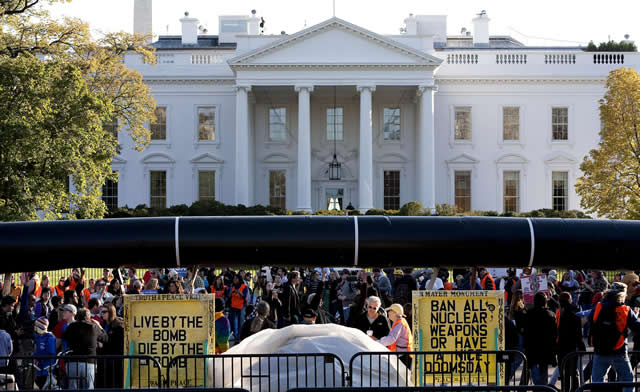Keystone XL Jobs vs. Subsidized Green Jobs
Nicolas Loris /

Demonstrators carry a giant mock pipeline while calling for the cancellation of the Keystone XL pipeline during a rally in front of the White House in Washington November 6, 2011.
President Obama criticized the job estimate numbers from the construction of the Keystone XL pipeline in an interview with The New York Times over the weekend, but if the president wants to complain about job creation, he should really take a look as his failed green jobs programs.
While there has been disagreement over the number of construction and permanent jobs Keystone XL will create, building and operating Keystone XL will result in real private-sector jobs that will grow our economy. This is much different than the President’s taxpayer-funded green jobs plan that merely siphons resources out of the market and forces pricier energy on the American public.
In the interview with the Times, President Obama laughed off the notion that Keystone XL would be a big jobs creator in the interview:
Republicans have said that this would be a big jobs generator. There is no evidence that that’s true. And my hope would be that any reporter who is looking at the facts would take the time to confirm that the most realistic estimates are this might create maybe 2,000 jobs during the construction of the pipeline—which might take a year or two—and then after that we’re talking about somewhere between 50 and 100 [chuckles] jobs in a economy of 150 million working people.
But those are not the facts or the most realistic estimates, especially when it comes to the number of construction and indirect jobs Keystone XL would create. Simply building the southern portion of the pipeline—which didn’t need the President’s approval—has already created 4,000 construction jobs. And the President’s own State Department estimates 42,000 direct and indirect jobs during the pipeline’s construction.
The President is right in saying that there would likely be fewer than 100 permanent jobs for Keystone XL, but the pipeline would also provide a secure source of oil to be refined in American refineries and billions of dollars in property tax revenue for the states where Keystone XL runs.
Further, the jobs numbers projected by for his Department of Energy loan guarantee program all have fewer temporary construction jobs (except 3,000 for Solyndra, and we know how well that turned out) and similar permanent jobs numbers. In fact, the taxpayer exposure as a result of the loan guarantees are over $6 million per permanent job created. Here are a few examples in the loan guarantee program:
- Abengoa Solar (Mojave Solar) received a $1.2 billion loan guarantee for 830 construction jobs and 70 permanent jobs;
- Congentrix, once owned by a subsidiary of Goldman Sachs, received a $90 million loan guarantee for a solar project that would provide 70 construction jobs and 10 permanent jobs;
- Granite Reliable Wind received a $170 million loan guarantee to create 198 temporary and six permanent jobs;
- NRG Solar received a $1.23 billion loan guarantee that provided 350 construction jobs and 15 permanent jobs; and
- The number of permanent jobs for Solyndra and Abound Solar are not available, but the real number is a giant goose egg, because they’re both bankrupt, as are a number of other subsidized green projects.
The Administration’s green jobs programs are not jobs creators but simply shift resources to politically preferred technologies and interests. And even if government-backed companies are successful, that just means they could have secured private investments rather than relying on Washington funding.
There is nothing wrong with more renewable energy or alternative fuels replacing conventional resources of energy, but if that shift occurs, it will be driven by market forces, not dictated through government policy.
The President shouldn’t dismiss the jobs the private sector would create in building and operating Keystone XL and instead take a hard look at his failed subsidized green jobs approach. We know what works and what doesn’t. The free market is driving an energy revolution, while government spending programs and onerous and duplicative regulations are stripping Americans from those successful endeavors.
